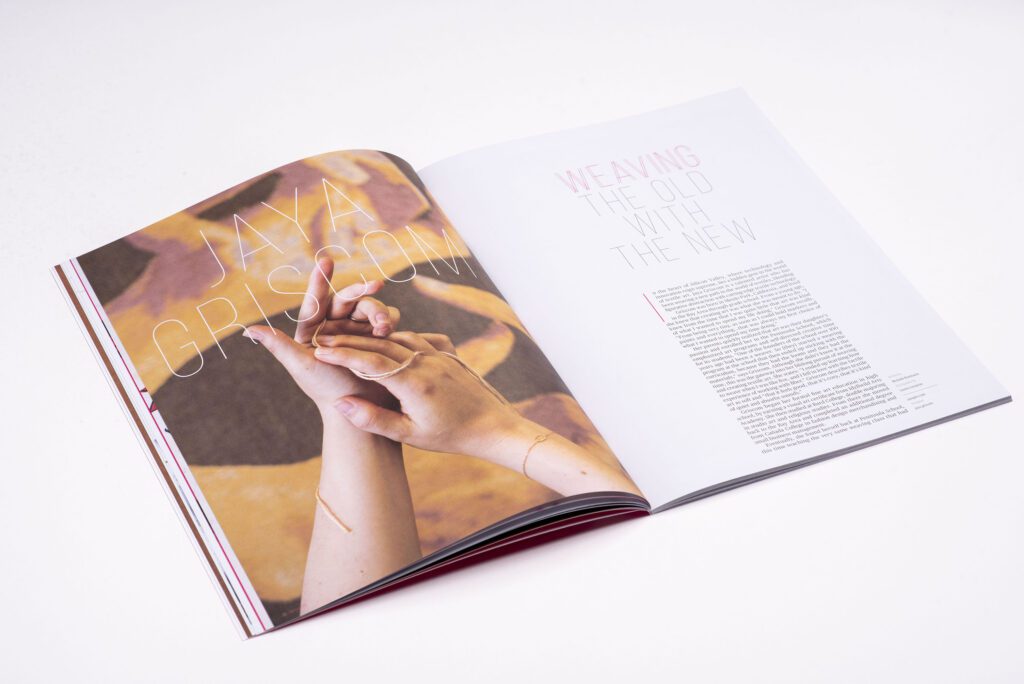In the heart of Silicon Valley, where technology and innovation reign supreme, lies a hidden gem in the world of textile art. Jaya Griscom is a talented artist who has been weaving a new path in the world of textiles, blending figurative abstraction with cutting-edge textile technology. Griscom was born in Menlo Park, California, and lived in the Bay Area through grade school. From a young age, she knew that creating art was what she was meant to do. “I knew from the time that I was quite little that art was kind of what I wanted to spend my life doing,” Griscom recalls. “From being very tiny, as soon as I could hold markers and paints and everything…that was always my first choice of what I wanted to spend my time doing.”
Her parents quickly realized that art was their daughter’s passion and enrolled her in the Peninsula School, which emphasized art programs and self-directed creative time for its students. “One of the founders of the school over 100 years ago had been a weaver. So [they] started a weaving program at the school that then ended up sticking with the curriculum, because they had the looms and they had the materials,” says Griscom. Although she didn’t know it at the time, this was the gateway into her lifelong pursuit of weaving and creating textile art. She states: “I ended up learning how to weave when I was like five, and I fell in love with the tactile experience of working with fiber.” Griscom describes textile art as soft and “that it feels good, that it’s cozy, that it’s kind of quiet and absorbs sounds.”
“Operating on a scale that is at least as large as the human body, if not larger, has a very different kind of physical relationship when you’re viewing or touching it.”

Griscom began her formal fine art education in high school, by earning a visual art certificate from Idyllwild Arts Academy. She then studied at Bard College, double majoring in studio art and religious studies. From there she moved back to the Bay Area and completed an additional degree from Cañada College in fashion design merchandising and small business management.
Eventually, she found herself back at Peninsula School, this time teaching the very same weaving class that had inspired her as a child. “It was wonderful to be back. I love being in the classroom,” recalls Griscom. As with so many educators, Griscom’s job was impacted by the pandemic, and she was forced to shift to remote work. “Teaching anything remotely is certainly not optimal, but specifically teaching something that is so hands-on and material intensive was really challenging to make work.” While she made teaching work remotely for a while, she decided it was no longer a fit without being in-person and instead focused more attention on her own practice.
Working with various types of looms, from traditional to new age, has allowed Griscom to create both simple and complex designs. Most recently, she was excited to have access to a digital Jacquard loom through a residency program at Praxis Fiber Workshop in Cleveland, Ohio. This loom unlocked new opportunities for creating more photorealistic designs, which often depict human features such as hands. “The human body is fascinating, and I think that as much as we all are so familiar with bodies…it can be a really exciting way to kind of reexamine that connection with self, as well as reexamine the hefty societal expectations placed on ourselves in terms of physical appearance.”
Griscom makes a point to share that the intersection of the ancient art of weaving and modern technology isn’t new. “There have always kind of been these parallels in this dialogue between computer coding and weaving.” She adds, “You have warp strings, your vertical strings. You have your weft strings, your horizontals. It’s either a weft on top of a warp, or it’s a warp on top of a weft. It’s a zero or one, like it is with binary code.”
Griscom has also recently started combining prints, repurposed clothes, and 3D contours into her larger-scale textile artwork. Griscom admitted that while she does enjoy art in all sizes, she’s found herself drawn to larger pieces. “Operating on a scale that is at least as large as the human body, if not larger, has a very different kind of physical relationship when you’re viewing or touching it,” she shares. As a result, she has been accepted into the Cubberley Artist Studio Program in Palo Alto, which provides a large studio for bigger projects. Griscom is excited to continue to expand her practice with new techniques and materials, weaving the old and new together.
jayagris.com
Instagram: jaya.griscom

